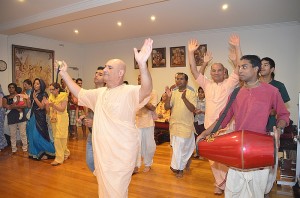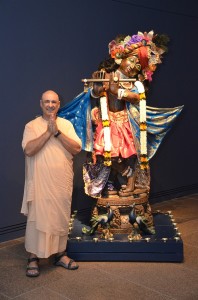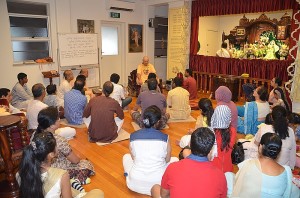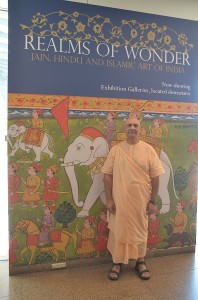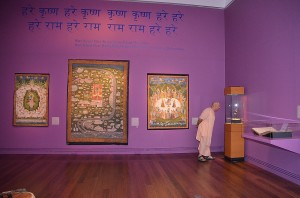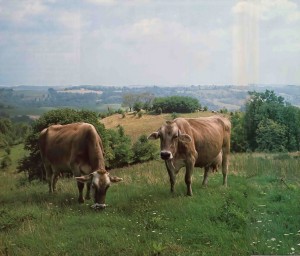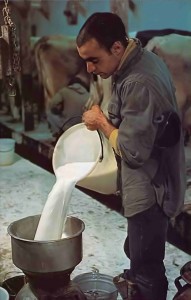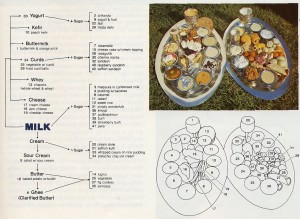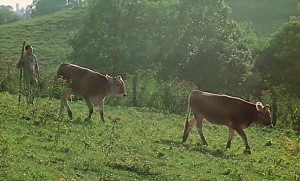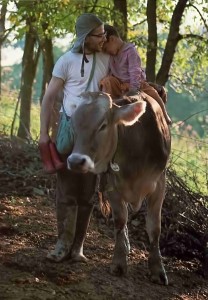When the Gita instructs sarva dharman parityajya why does a devotee need to perform apara dharma?
BTG Article About ISKCON Toronto & Montreal from 1983!
→ The Toronto Hare Krishna Temple!
Eastern Canada’s Krsna Culture
The traditional chanting, dancing, and worship are all going strong, but there’s much more.
by Amogha Dasa
About a decade ago the Hare Krsna devotees in Canada bought two churches—one in Toronto and one in Montreal—and caused a bit of consternation. Their neighbors wondered just who they were and what they were going to do.
 |
| The Hare Krsna church-turned-temple stands proudly on Avenue Road, one of Toronto’s busiest thoroughfares. |
Still, for many Canadians the questions remain: What do the Hare Krsnas do? And why?
Nandikesvara dasa, president of the center in Montreal, explained, “We live according to the Vedic scriptures, such as Bhagavad-gita and Srimad-Bhagavatam. These books were introduced here in the late sixties and early seventies by His Divine Grace A.C. Bhaktivedanta Swami Prabhupada, the founder and spiritual guide of the Hare Krsna movement. He translated them from the original Sanskrit and explained them in elaborate purports. To understand our activities here in eastern Canada, you have to understand something of the principles laid down in these scriptures.”,
For several weeks last summer I lived with the Canadian devotees and saw how they put these principles into practice.
As in all Hare Krsna temples, the devotees in Canada begin the day at 4:30 in the morning with a formal arati ceremony. Accompanying themselves on drums and hand cymbals, they sing prayers to the spiritual master, a pure representative of Krsna and the devotees’ spiritual guide and source of inspiration. Then they chant the Hare Krsna mantra in chorus.
 |
| Devotees follow the lead of temple president Visvakarma dasa (beating the blue drum) as they chant Hare Krsna in downtown Toronto |
For an hour and a half after the arati softly on beads (see page 4 for more details). Then it’s time for a class in the Srimad-Bhagavatam. Laksminatha dasa, president of the center in Ottawa, told us of its significance: “By hearing the Bhagavatam every morning, we feel tangible spiritual improvement. The Bhagavatam is the foremost of all Vedic literatures because it deals with nothing except the instructions and activities of Lord Krsna and His devotees. The Lord is within each of us, and, as the Bhagavatam itself explains, He purifies our heart and gives us transcendental knowledge when we regularly hear about Him. Ultimately He reveals Himself to us. So the morning Bhagavatam class is a vital part of every devotee’s practice of Krsna consciousness.”
After the class, everyone rises to sing more prayers glorifying the spiritual master. Then it’s breakfast time, followed by the start of the day’s devotional activities.
 |
| Nandikesvara dasa, leader of the Montreal center, play a traditional Indian tamboura as he sings the glories of Lord Krsna. |
Visvakarma also told me about his large congregation of Indian life members. They’ve seen that the devotees are following the genuine Vedic culture, so they enthusiastically support the temple. Two members, Syama-Krsna dasa and his wife, Kunti-devi dasi, recently took spiritual initiation from Srila Gopala Krsna Go-swami, who oversees the movement’s affairs in Canada and initiates new disciples there.
 |
| At a shopping mall in downtown Ottawa, Gaura dasa interests some youngsters in the latest issue of BACK TO GODHEAD. |
Her husband added, “What inspired us was that we saw that we didn’t have to give up our regular life. We could carry on with that and yet advance spiritually and make Krsna the center of our life. We could do everything for Krsna and help spread Krsna consciousness.”
 |
| Mrs. Elizabeth Mohar, one of several thousand members of the Toronto temple’ s congregation, prays to Lord Krsna during an outdoor festival last summer. |
 |
| Newly initiated Syama -Krsna dasa and his wife, Kuntidevi dasi, throw grains into the fire during a ceremony held last summer in the Toronto temple. |
I also learned that another troupe, in Toronto, puts on a play based on the Ramayana, the epic about Krsna’s incarnation Lord Ramacandra. And I heard that one devotee performs ballet and classical Indian dance to portray the Lord’s pastimes.
 |
| Bhakta Luc pantomimes someone trying to control the earth. |
 |
| Deep in creative concentration, Visnu dasa puts the finishing touches on the backdrop for the altar in the Toronto temple. |
“What do you think of that?” Nandikesvara asked.
“Fantastic!”
 |
| Mahavirya dasa sings of Krsna in Montreal. |
“The devotees did it all themselves,” he told me.” Abhay Charan made the wrought-iron table legs and matching chairs, Dana-keli did the plumbing, wiring, and kitchen installations, and Visnu dasa hand-painted the wall mural.” This monumental piece of artwork consists of seventeen panels separated by hand-cast columns and arches.
 |
| Two patrons toast each other’s health with apple juice. The ornate columns and arches, as well as the mural depicting Krsna in the spiritual world, are all products of the devotees’ own artistry |
 |
| Devotees dish out plate after plate of prasadam (sanctified food) to eager celebrants at a festival in Montreal |
I Kept Fixed On Just Hearing
→ Japa Group
I kept fixed on just hearing and did not have many good japa thoughts. I was content to just occupy myself in the yajna of the sound vibration.
Satsvarupa dasa Goswami
From Bhajana Kutir #35
Texas library offers no books
→ View From a New Vrindaban Ridge
The all-digital facility is on pace to surpass 100,000 visitors in its first year.
A computer screen displays books available at BiblioTech, a first of its kind digital public library Wednesday in San Antonio. BibiloTech is the nation’s only bookless public library.
SAN ANTONIO — Texas has seen the future of the public library, and it looks a lot like an Apple Store: Rows of glossy iMacs beckon. iPads mounted on a tangerine-colored bar invite readers. And hundreds of other tablets stand ready for checkout to anyone with a borrowing card.Even the librarians imitate Apple’s dress code, wearing matching shirts and that standard-bearer of geek-chic, the hoodie. But this $2.3 million library might be most notable for what it does not have — any actual books.
That makes Bexar County’s BiblioTech the nation’s only bookless public library, a distinction that has attracted scores of digital bookworms, plus emissaries from as far away as Hong Kong who want to learn about the idea and possibly take it home.”I told our people that you need to take a look at this. This is the future,” said Mary Graham, vice president of South Carolina’s Charleston Metro Chamber of Commerce. “If you’re going to be building new library facilities, this is what you need to be doing.”All-digital libraries have been on college campuses for years. But the county, which runs no other libraries, made history when it decided to open BiblioTech. It is the first bookless public library system in the country, according to information gathered by the American Library Association.Similar proposals in other communities have been met with doubts.
In California, the city of Newport Beach floated the concept of a bookless branch in 2011 until a backlash put stacks back in the plan. Nearly a decade earlier in Arizona, the Tucson-Pima library system opened an all-digital branch, but residents who said they wanted books ultimately got their way.Graham toured BiblioTech in the fall and is pushing Charleston leaders for a bond measure in 2014 to fund a similar concept, right down to the same hip aesthetic reminiscent of Apple.Except Apple Stores aren’t usually found in parts of town like this. BiblioTech is on the city’s economically depressed South Side and shares an old strip mall with a Bexar County government building.On a recent afternoon, one confused couple walked into the library looking for the justice of the peace.
San Antonio is the nation’s seventh-largest city but ranks 60th in literacy, according to census figures. Back in the early 2000s, community leaders in Bibliotech’s neighborhood of low-income apartments and thrift stores railed about not even having a nearby bookstore, said Laura Cole, BiblioTech’s project coordinator. A decade later, Cole said, most families in the area still don’t have Wi-Fi.”How do you advance literacy with so few resources available?” she said.Residents are taking advantage now. The library is on pace to surpass 100,000 visitors in its first year.
Finding an open iMac among the four dozen at BiblioTech is often difficult after the nearby high school lets out, and about half of the facility’s e-readers are checked out at any given time, each loaded with up to five books. One of BiblioTech’s regulars is a man teaching himself Mandarin.Head librarian Ashley Elkholf came from a traditional Wisconsin high school library and recalled the scourges of her old job: misshelved items hopelessly lost in the stacks, pages thoughtlessly ripped out of books and items that went unreturned by patrons who were unfazed by measly fines and lax enforcement.But in the nearly four months since BiblioTech opened, Elkholf has yet to lend out one of her pricey tablets and never see it again.
The space is also more economical than traditional libraries despite the technology: BiblioTech purchases its 10,000-title digital collection for the same price as physical copies, but the county saved millions on architecture because the building’s design didn’t need to accommodate printed books.”If you have bookshelves, you have to structure the building so it can hold all of that weight,” Elkholf said. “Books are heavy, if you’ve ever had one fall on your foot.”Up the road in Austin, for example, the city is building a downtown library to open in 2016 at a cost of $120 million. Even a smaller traditional public library that recently opened in nearby suburban Kyle cost that city about $1 million more than BiblioTech.
On her first visit, 19-year-old Abigail Reyes was only looking for a quiet space to study for an algebra exam. But she got a quick tutorial from a librarian on how to search for digital books and check out tablets before plopping down on a row of sleek couches.”I kind of miss the books,” Reyes said. “I don’t like being on the tablets and stuff like that. It hurts my eyes.”Across the room, Rosemary Caballeo tried shopping for health insurance on a set of computers reserved for enrollment in the Affordable Care Act. Her restless 2-year-old ran around and pawed at a row of keyboards. The little girl shrieked loudly, shattering the main room’s quiet. She was soon whisked outside by her father.After all, it’s still a library.
Filed under: News, Ramblings or Whatever
Dreamstime.com Carries Photos of Toronto’s Festival of India!
→ The Toronto Hare Krishna Temple!
Dreamstime is one of the world leaders in stock photography and a reliable supplier of high quality digital images. Online since 2000 as a Royalty-Free stock photography website, Dreamstime has evolved into a powerful and active community-based site. Their database is renewed with thousands of fresh images and titles on a daily basis.
Check out the images that show up by clicking here!
New Vrindavan daily Darsan @ January 6, 2014.
→ New Vrindaban Brijabasi Spirit
Please click here for all photos
What is the use of the highest royal pleasures? What is the use of perfecting the yoga-system and travelling to the upper planets? What is the use of the great variety of material endeavors to attain useless ends? These things are insignificant in comparison to residence in Vrindavana. Simply by living in Vrndavana I will one day hear the sweet sound of Krishna’s flute, which brings the ultimate bliss.
[Source : Nectarean Glories of Sri Vrindavana-dhama by Srila Prabodhananda Sarasvati Thakura, 1-28 Translation ]
SB 01.05.12 – Cultivate conscientious concentration by contemplating the valuelessness of everything else
→ The Spiritual Scientist
Taking over everything
→ KKSBlog
(Kadamba Kanana Swami, 01 March 2012, New York, USA, Lecture)

Everything is bound by time but the maha-mantra is eternal. So many things change in our life – it’s just amazing what can change – but somehow or other, this chanting never changes. It is constant because the name is Krsna himself who descends from the spiritual world and is not bound by time; therefore this is the one constant thing in our life, the one thing that stays!
Everything else may crumble with time but this does not crumble. Rather, every time we chant the mantra, it will never be lost. Each time we chant the mantra, it piles on top of each other and just builds up. So in this way, our chanting will just gain in strength, in depth, and gradually it will take over everything. At that stage one becomes transcendental.
Adelaide Temple
→ Ramai Swami
The Adelaide temple management organised programs every night at the temple for my last visit there. It was nice to see so many devotees attend even though the temperature outside was over 40 degrees that week. Luckily, there is air-conditioning in the temple so we danced in kirtan without feeling too hot.
ISKCON Scarborough – His Grace Sriman Sankarshan Das Adhikari will be giving a special class coming Friday
→ ISKCON Scarborough
Please accept our humble obeisances!
All glories to Srila Prabhupada!
All glories to Sri Guru and Sri Gauranga!
We are delighted to inform you that H.G Sriman Sankarshan Das Adhikari and Her Grace Visnupriya Mataji will be back at ISKCON Scarborough coming Friday - 10th Jan 2014.
Prabhu will be giving a special class on the topic "Stop Worrying, Start Living".
Prabhu has previously conducted two wonderful seminars at ISKCON Scarborough in 2012 and in 2013:
- "Uttama Bhakti" in March 2012
- "Modern day Paramahamsa - How to be in Krsna Consciousness in Household life" in Jan 2013
The full you tube video presentations can be seen in www.youtube.com or through www.iskconscarborough.com
The program schedule on Friday at ISKCON Scarborough - Jan 10th 2013:
6.45 pm to 7 pm - Tulasi arti
7 pm to 8 pm - class on the topic - "Stop Worrying, Start Living"
8 pm to 8.30 pm - Arti
8.30 pm to 8.45 pm - 1 round group chanting of Hare Krsna maha Mantra
8.45 pm - Grand free vegetarian feast
We welcome you, your family and friends to ISKCON Scarborough for the wonderful weekend programs:
- Association with HG Sankarshan Das Adhikari on Friday (Jan 10th 2014)
- To take part in the glorious 8 hour Kirtan on Saturday night from 10 pm to 6 am
His Grace Sriman Sankarshan Das Adhikari appeared in this world in St. Louis, Missouri, USA on 7 November 1947, the tenth day (Dasami) of the most holy month of Kartik according to the Vaisnava calendar. He first met his spiritual master, His Divine Grace A.C. Bhaktivedanta Swami Prabhupada, in 1971 and was initiated by him on 12 August of the same year. Srila Prabhupada personally told this new young disciple that he was pleased with his sincerity and enthusiasm for spreading the Krishna consciousness movement. Sankarshan Das fully dedicated his life for serving the order of his spiritual master to become a guru and deliver the world. For the last 40 years he has uninterruptedly served his spiritual master’s movement, the International Society for Krishna Consciousness (ISKCON), in various capacities.
In the year 2000, in recognition for his full dedication to Srila Prabhupada’s mission, ISKCON’s Governing Body Commission (GBC) gave him their blessings to initiate disciples. Since that time he has been regularly traveling and lecturing extensively all over the world for reviving the dormant Krishna consciousness in the hearts of all living beings. Well known for his Internet based training program, the Ultimate Self Realization Course, he has attracted over 12,000 subscribers from over 100 different countries who receive a daily inspirational message and personal answers to their questions regarding how to become perfect in Krishna consciousness. Those who are interested can join his course at: www.backtohome.com
With best wishes from,
ISKCON Scarborough
3500 McNicoll Avenue, Unit #3,
Scarborough,Ontario,
Canada,M1V4C7
Email Address:
iskconscarborough@hotmail.com
website:
www.iskconscarborough.com
How Vedanta makes the transcendental accessible
→ The Spiritual Scientist
Though Vedanta deals with ordinary language quite dovetailing the views of ordinary intelligentsia to gradually heave them up to the super-sensuous regions where senses cannot work by their present implements or cannot help them by the words of their credulous friends, still the transcendental topics are imparted slowly through the linguistic and rationalistic attainments to differentiate the plane of transcendence and the undesirable transformable plane of enjoyments. As it is helping the journey of understanding we need not stick to a stagnant view in order to gratify our senses at the cost of rationality and harmonious language exactly fitting our whims. So the method of studying this particular philosophy should never be confined to the same process of confusing the transcendence with our present plane of thought.
- Srila Bhaktisiddhanta Saraswati Thakura, The Vedanta – Its Morphology and Ontology
Makara Sankranti
→ New Vrindaban

On the 14th of January the Sun planet moves into Capricorn marking Uttarayana. This day is considered very auspicious by all spiritualists as this was the day chosen by Bhishma to go back to the spiritual world. On this day a big “Ganga Sagar mela” is held in Bengal where all the ancestors are given “tarpana” for their spiritual development. According to the Puranas, on this day Surya (Sun) visits the house of his son Shani (Saturn), who is the lord of the Makara rashi (Capricorn). Though the father and son duo did not get along well, the Surya made it a point to meet his son on this day. He, in fact, comes to his son's house for a month. This day thus symbolises the importance of the special relationship between father and son. Hence it is all the more auspicious.
Glories of Makara Sankranti in Scriptures:
It was on this day when Lord Vishnu ended the ever increasing terror of the asuras (demons) by finishing them off and burying their heads under the Mandara Parvata. So this occasion also represents the end of 'negativities' and beginning of an era of righteous living.
Maharaja Bhagiratha, performed great penance to bring Ganga down to the earth for the redemption of 60,000 sons of Maharaja Sagara, who were burnt to ashes at the Kapil Muni Ashramam, near the present day Ganga Sagara. It was on this day that Bhagiratha finally did tarpanawith the Ganges water for his unfortunate ancestors and thereby liberated them from the curse. After visiting the Pataala (underworld) for the redemption of the curse of Bhagiratha's ancestors the Ganges finally merged into the sea. A very big Ganga Sagara Mela is organised every year on this day at the confluence of River Ganges and the Bay of Bengal. Thousands of Hindus take a dip in the water and perform tarpanA for their ancestors
"Celebration in New Vrindaban on 14th Jan:
In New Vrindaban we have decided to hold a special “Mahayajna” for our devotees and we invite you to be a part of it. We are performing this yajna for the spiritual development of your whole family and for your ancestors. You can sponsor a yajna in the name of your family for $151. We will pray for your family. Please provide us with the names of your family members nakshatra and gotra and your beloved elders whose name you would like to add as well. You will get Narasimha Kavacha and prasada.
Cow feeding :
This day is auspicious to feed the cow with Til and Jaggery. It is said all your sins will be eradicated by feeding the cow on this day. We will do it on your behalf and we will do a cow puja as well for $108.
Brahmana Bhojana :
Brahmana Bhojana is also very important to serve the Brahmanas. Krishna eats through the brahmanas, so by sponsoring a brahamana feast on this day you will get the special blessings of all the brahmanas and they will be elevated to higher lokas. Brahmana bhojana is $501.
On the donation form there is a place to put family member names. Please put your family member names there there.
Rich With Ancient Culture
→ travelingmonk.com
Miss You
→ travelingmonk.com
Prabhupada Letters :: Anthology 2014-01-06 16:59:00 →
Prabhupada Letters :: 1969
A visit to the ancient Vaishnava treasure of Thiruvananthapuram (Album 91 photos)
→ Dandavats.com
 Indradyumna Swami: Today in Thiruvananthapuram we visited a temple of Lord Parasurama, a 1,300 year old Siva temple and a Krishna temple built by Bhima 5,000 years ago. The state of Kerala is rich with the ancient culture of India. [ Photos by myself and 5 by Narottam das Thakur das ] -- Read more ›
Indradyumna Swami: Today in Thiruvananthapuram we visited a temple of Lord Parasurama, a 1,300 year old Siva temple and a Krishna temple built by Bhima 5,000 years ago. The state of Kerala is rich with the ancient culture of India. [ Photos by myself and 5 by Narottam das Thakur das ] -- Read more › Prabhupada Letters :: Anthology 2014-01-06 16:48:00 →
Prabhupada Letters :: 1970
Prabhupada Letters :: Anthology 2014-01-06 16:46:00 →
Prabhupada Letters :: 1971
Prabhupada Letters :: Anthology 2014-01-06 16:43:00 →
Prabhupada Letters :: 1972
Prabhupada Letters :: Anthology 2014-01-06 16:42:00 →
Prabhupada Letters :: 1974
Prabhupada Letters :: Anthology 2014-01-06 16:40:00 →
Prabhupada Letters :: 1974
Prabhupada Letters :: Anthology 2014-01-06 16:39:00 →
Prabhupada Letters :: 1974
Harinama in Bondi Beach, Sydney, Australia (Album 16 photos)
→ Dandavats.com
 Bondi Beach or Bondi Bay is a popular beach and the name of the surrounding suburb in Sydney, New South Wales, Australia -- Read more ›
Bondi Beach or Bondi Bay is a popular beach and the name of the surrounding suburb in Sydney, New South Wales, Australia -- Read more › Prabhupada Letters :: Anthology 2014-01-06 16:29:00 →
Prabhupada Letters :: 1975
New Year Harinam In Osaka, Japan (Album 18 photos)
→ Dandavats.com
 Kavicandra Swami: This is new year harinam in OSAKA, Japan. This is one of the biggest ever. I am so happy to see the growth and the blissful faces. Bhaktin Akiyo with the accordion is a powerful preacher there. At Gaura PUrnima she will take initiation from HH Kesava Bharati Goswami -- Read more ›
Kavicandra Swami: This is new year harinam in OSAKA, Japan. This is one of the biggest ever. I am so happy to see the growth and the blissful faces. Bhaktin Akiyo with the accordion is a powerful preacher there. At Gaura PUrnima she will take initiation from HH Kesava Bharati Goswami -- Read more › A Winter Ratha-Yatra? Help Us Source this Photo!
→ The Toronto Hare Krishna Temple!
Have you seen this photo before? Care to take an educated guess where this is from? We're curious to know if any of our readers might be able to help us source this photo. Leave a comment with your thoughts or guesses!
January 6th, 2014 – Darshan
→ Mayapur.com
The post January 6th, 2014 – Darshan appeared first on Mayapur.com.
New Vrindaban Cow Protection: Practical Necessity for a Peaceful Society – BTG Magazine 1976
→ New Vrindaban Brijabasi Spirit
New Vrindaban Cow Protection: Practical Necessity for a Peaceful Society
Back To Godhead Magazine, January 1976
By Vishaka devi dasi
Speaking on the troubled condition of our modern world, the late historian Arnold Toynbee once said, “The cause of it [the world's malady] is spiritual. We are suffering from having sold our souls to the pursuit of an objective which is both spiritually wrong and practically unobtainable. We have to reconsider our objective and change it. And until we do this, we shall not have peace, either amongst ourselves or within each of us.”
The conditions of our urbanized, technology-oriented society that prompted Dr. Toynbee’s remarks are no mystery to us. Especially in the West, and increasingly in the rest of the world, the mad quest for artificial luxuries has created a chaotic atmosphere pervaded by greed and power-seeking. The goal of life? “How many ways can I make money?” and “How many ways can I spend it?” The results of such a philosophy are painfully evident: internationally, we face the risk of nuclear destruction; nationally, crime waves and political corruption rule the land; and individually, we are plagued with anxiety, frustration and despair.
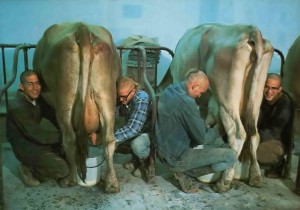
In the peaceful hill country near Moundsville, West Virginia, a sprawling thousand acre farm called New Vrindaban gives sanctuary to cows, guaranteeing them a long and happy life in return for their bountiful supply of milk. Milking the cows is a cheerful activity for the herdsmen who appreciate the animals’ good temperament.
This is the unfortunate result of a society without spiritual direction. According to the Vedic scripture Srimad-Bhagavatam, a truly peaceful, progressive society must be based on service to God. Such a spiritually evolved civilization actually flourished on this planet five thousand years ago and the people were rich in both spiritual and material assets. The Supreme Lord was pleased with the service rendered by the citizens, and thus He profusely supplied the necessities of life milk, food grains, fruits, vegetables, silk, cotton, minerals and jewels. Being fully satisfied spiritually, people did not look for pleasure in artificial sensual stimulation indulged in at the cost of health and sanity. People lived simply, close to nature and close to God free of the encumbrances of a modern mechanistic civilization. Dwelling on tracts of land suitable for complete self-sufficiency, Vedic agricultural families used all the resources at hand. Because the cows were treated very affectionately and protected from any harm, they were very joyful and secure. Thus, they contributed much greater amounts of milk than today’s animals. The very valuable cow dung was used not only as a fertilizer but also as a heating and cooking fuel, and even as a cleanser. (Modern science has confirmed the disinfectant properties of cow dung.) And bulls provided the muscle for plowing and harvesting the fields, milling the grain, and pulling oxcarts full of people and commodities.
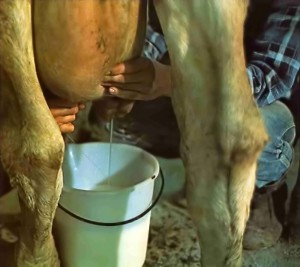
Jets of warm milk squirt into a bucket from a cow’s generous udder. Buckets are then poured into ten-gallon cans. On a good day, a Holstein fills up one can with eighty pounds of milk.
Accustomed as we are to modern conveniences, we may regard such a life as primitive and far from ideal. However, when the Supreme Lord Sri Krsna appeared on this planet five thousand years ago, He showed by His own example that for both material prosperity and spiritual advancement, human civilization must maintain the cow and bull very carefully.
At New Vrindaban, ISKCON’s Vedic village near Moundsville, West Virginia, Lord Krsna’s example is being put into practice. Established by His Divine Grace Srila Prabhupada nine years ago, New Vrindaban now spreads over one thousand acres of hilly farmland and is a perfect example of the benefits derived from organizing society according to the principles of cow protection and service to Krsna. Kirtanananda Swami, leader of the New Vrindaban community, describes the project’s purpose: “It is a great vision of presenting to everyone, not only in this country but in the whole world, how one can become Krsna conscious living just as Krsna lived in Vrindaban, depending on nature and the cows.”
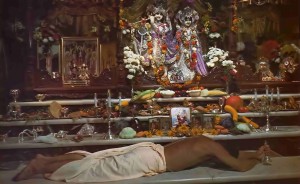
A devotee offers dairy foods and a variety of the farm’s harvest to please Lord Krishna on the altar at New Vrindaban.
The following is a conversation between BTG staff photographer Visakha-devi dasi and two cowherd men of New Vrindaban.
Visakha dasi: You seem to enjoy working with cows very much. Can you tell us why?
Ambarisa dasa: The cows here at New Vrindaban are special. You can sense this immediately when you come in contact with them. They’re Krsna’s cows. They’re very dear to Krsna, and when you work with them it’s easy to remember Him. They’re mellow and their temperament reflects on you.
You have to approach them with an attitude of service. By relating to them on a personal basis and serving them with a humble attitude, you can see them as living beings with feelings and personalities. Most farmers raise cows with a dollar sign in their mind. It’s very impersonal. Regular dairy farmers or ranchers use the cow as a machine or a tool for their own selfish ends. It’s very gross. But when we serve Krsna’s cows, we realize that each one has a specific personality.
Visakha dasi: Why do you say that these cows at New Vrindaban are Krsna’s cows? Aren’t all the cows everywhere Krsna’s cows?
Ambarisa dasa: Yes, but these cows are special. They belong to Krsna even more because they’re serving Krsna more. That is, their milk is being offered to Krsna in the temple here. That’s why we take so much trouble with them. Because the milk they give is for the pleasure of Lord Krsna. Also, these cows are happier than cows on other farms. Most farmers send their cows to the slaughterhouse when they get to be a certain age. The cows know they’re going to be slaughtered they can sense it. They seem very sad, so they’re less attractive. But our cows know they’re not going to be slaughtered they know they’re being protected. They’re a lot happier, and they give lots of milk.
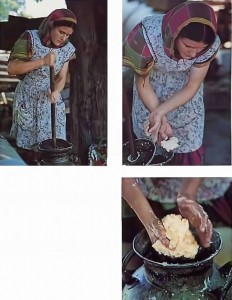
Every day at four P.M., the cream from the day’s two milkings is churned into butter by Viduttama dasi. Inside the can, the rod she holds is attached to a round wooden disc with a sawtoothed edge. When the rod is moved up and down, the disc churns the cream into a rich, light-colored butter.
Visakha dasi: What’s your daily routine?
Ganendra dasa: One of the best things about working with cows is that your life becomes well regulated. We get up at two in the morning to milk the cows. It’s very nice because we know we’re doing it just to please Lord Krsna. It puts us right on the transcendental plane first thing in the day.
The schedule fits in nicely with our temple routine. We milk the cows at two o’clock, and as soon as we’re done milking, we go into the temple and attend the morning functions. We’re busy all the time this way, and we don’t fall down to a mundane level. The early morning hours are the best time for spiritual practice.
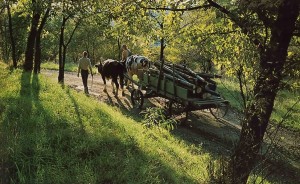
Afternoon sun streams through late summer foliage as an ox team hauls logs for winter firewood out of the forest. Bulls are needed as much as cows in a Vedic community; besides hauling, they plow the fields, grind the grains, and provide transportation. The trio of bulls, cows and land forms the central structure of Vedic economy.
Ambarisa dasa: Cows are the most regulated animals I know. They eat at a certain time, are milked at a certain time, go out to the fields at a certain time, walk so many hours a day, chew their cud for so many hours a day. Their bodies function on a tight schedule, and whenever this schedule is upset even a little bit, they immediately let you know. So you have to be really fixed in your duty. You have to think, “If I don’t milk the cows, they’ll get sick, and then they won’t give any milk.” The devotees who are cooking the food that gets offered to Krsna are thinking the same thing “If I don’t cook this offering for Krsna, then He won’t get anything to eat.” The consciousness is very personal, very nice.
Ganendra dasa: It’s just like with people. There’s always an exchange of feelings. Since the cow is a person too, when we become friendly toward them, each cow responds personally. That’s how cows are the more affectionate you are to them, the more affectionate they are to you. They give more milk and are happier.
Ambarisa dasa: That’s one thing about New Vrindaban. All the animals here are free from anxiety, and anyone who comes here feels that and also becomes free from anxiety. Recently a newspaper reporter visited us, and he wrote in his article that when you’re at New Vrindaban you may not realize how free from the mundane rat race you are, but as soon as you go back you understand that you’ve been in a transcendental place.
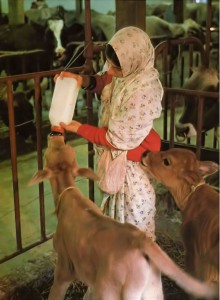
Feeding the calves half gallons of milk at a time, Vijaya dasi fills in for the mother cows. When feeding directly from their mothers, calves often get sick from their inevitable overindulgence. For cows, calves and bulls to live happily, human beings must protect them.
Visakha dasi: Do you think it’s practical to put so much emphasis on the cow?
Ganendra dasa: Well, we’ve seen here that cows actually can support human society materially and spiritually. In fact, that’s the purpose of the cow. They give more milk than their calves can drink. So the extra milk is meant for us it helps us develop a good brain for understanding spiritual life. Also, she supplies pure cow dung that can be recycled into the fields to cultivate the grains and the pastures. And the bull helps till the fields. In this way a perfect cycle is maintained. We cultivate crops on land fertilized with manure; then we offer the food to Lord Krsna: Krsna eats sumptuously, we eat sumptuously, the cows eat sumptuously, and everyone is satisfied.
On the other hand, slaughtering the cow is detrimental to everyone. The meat is harmful to your body and your brain. And the cow has been caused much pain, so there are great sinful reactions to suffer. If you protect the cows, give them what they want, and derive the benefits in the way Krsna intended, then when they die of their own accord you can use the skin for leather, if necessary. But you don’t have to kill cows.
The Srimad-Bhagavatam says the cow is an offenseless living being. It’s Krsna’s arrangement that the cow takes so little and gives so much. From her milk you can make hundreds of delicious preparations. She simply performs her service very peacefully without any bother to anyone. These are the qualities of an ideal devotee, and they’re reflected on those who work with the cows.
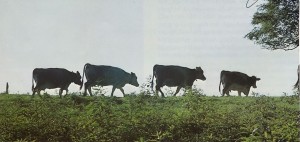
A local West Virginia newspaper recently called New Vrindaban’s 120 cows “one of the best dairy herds in the state.”
Snana Yatra 2013 Part 1 Melbourne
→ Gouranga TV - The Hare Krishna video collection
Snana Yatra 2013 Part 1 Melbourne
ISKCON Scarborough – 8 hour Kirtan coming Saturday night
→ ISKCON Scarborough
Please accept our humble obeisances!
All glories to Srila Prabhupada!
All glories to Sri Guru and Sri Gauranga!
On the glorious occasion of Vaikunta Ekadasi(Putrada Ekadasi), there will be a special fire sacrifice performed at ISKCON Scarborough followed by the 8 hour non stop Kirtan.
We are pleased to announce that taking part in this 8 hour Kirtan are Toronto's wonderful Gaura Shakti kirtan group, Radha Murari group, Kirtaneers from ISKCON Montreal, H.G Jagganath Misra das and several other kirtaneers.
Ekadasi prasadam will be served throughout Saturday night.
Special arti will be performed at 8 pm on Saturday and at 12 am and 6 am on Sunday.
The special event will conclude with a grand breakfast prasadam served on Sunday morning from 7.49 am onwards.
Schedule for this special event on Saturday - January 11th 2014:
6 pm - Fire Sacrifice
9 pm - Ekadasi prasadam
10 pm to 6 am - 8 hour non stop Kirtan
We welcome you, your family and friends to ISKCON Scarborough to take part in the wonderful celebrations on Saturday
With best wishes from,
ISKCON Scarborough
3500 McNicoll Avenue, Unit #3,
Scarborough,Ontario,
Canada,M1V4C7
Email Address:
iskconscarborough@hotmail.com
website:
www.iskconscarborough.com
Friday, January 3rd, 2014
→ The Walking Monk
Thursday, January 2nd, 2014
→ The Walking Monk
Today's
Today's most common phrase: It's cold! My remark: Try Siberia! Be happy! You're not that body!
Today's unique encounter: Meeting a couple. He, with origins form Sicily, she with origins from Greece, we sat and talked about the concept of, "monk/nun for a day", a six-hour experience of life in the ashram - to include mantra meditation, explanation of deities , a class on philosophy, some yoga, a discovery walk in the trails nearby, eating at Govinda's, some work in the kitchen, nine devotions workshop - charge a fee and open to the public.
Today's greatest moment: Walking and chanting in the snow and feeling no cold.
Today's best food: Curd, tomatoes, peppers, lightly spiced and offered to Krishna.
Today's greatest comfort: Sitting with two brahmacharis and brain-storming/ second to that - a much needed massage with hot oils and essence by Shyamasundara das - I only remember a minute of it, I fell asleep so fast.
Today's greatest challenge: Fighting of the drowsiness.
Today's greatest agitation: Behaviour of a congregant.
Today's greatest hope: The service ahead.
May the Source be with you!
6 KM
Wednesday, January 1st, 2014
→ The Walking Monk
2013 Rolled Over
2013 rolled over. 2014 like a morning lotus opened up. The midnight blast! The New Year's countdown, Old City Hall, excited many who immersed themselves at the Krishna corner. By 1 am the sound of the drum and the voices terminated while co-chanters headed back for the ashram by subway train, and I decided to trek it back. With snow boots on I found it somewhat cumbersome. This footwear is made for snow. Walking on cleared sidewalks with a pair of snow boots is like dragging your feet in clay-bound corn fields. As kids, this we used to do. Each step you took appeared to accumulate more muck. And while it was fun it also tended to put you into panic mode. "I'm stuck! How do I get out? Papa, help me!" is what we wanted to cry. The other fear was if Papa knew we were parading around in the neighbour's farm. He would give us a piece of his mind. We were kids. I gravitated this night (rather morning) to streets with snow edges. What a difference!
Our guru Srila Prabhupada used to say that in order to succeed in reaching another planet such as the moon, you require the attire suitable for the environment. His message to us was that we adjust our sails to different circumstances. The wind will always blow in some different directions so we must move in co-operation with the wind. So far, with the page of a new year turning over it's been a brrr... of a winter. Still, considering the recent big freeze and the ice storm which put power out for days in the Toronto area, life has to go on.
In Brampton, a sweet South Indian couple came forward for their diksas, a traditional initiation. They adjusted their old habits for new ones in order to make a progress that is granted in human life. Dharondev's name is Dharma das and Madhumati is now Manasi Ganga. We wish them well.
May the Source be with you!
2 KM
Tuesday, December 31st, 2013
→ The Walking Monk
Toronto, Ontario
Two Monks at New Year
I sat down with two of our young guys who have been treading the path of renunciation for some time. Brihat Mrdanga (formerly Jeff) has been with the mission for five years now and has traveled across Canada and India more than once since taking up the life of the cloth. He’s a great soul with a healthy spirit pushing on in his free celibate life.
Maha Mantra (formerly Matt) is our second Ontario chap to join within a short span of a golden period when a nice group of young men trickled in to become monks. Like Brihat Mrdanga he was looking at the New Year with openness.
The interesting thing about Brihat Mrdanga and Maha Mantra is that they reach a crossroads, not about being single and serving in a spiritual capacity like they have been doing, but instead of travelling throughout the Maritimes in a small bus together, with a third monk, Hayagriva of Quebec, or grounding themselves in our Montreal chapter, he expressed a small adjustment. Hayagriva likes to commit himself to sharing the Bhagavat philosophy in French Canada. Maha Mantra expressed a desire to be reaching out to youth based in Toronto and working within the parameters of the downtown Bhakti Lounge. And Brihat Mrdanga conveyed a passion for backpacking and cycling from city to city in the Maritimes, in the eastern most part of the country with another chosen renuonciant. Of course, this cycling around sounds quite adventurous, I mean, moving around with no particular fixed address, sounds a little like “the walking monk” genre of life.
The three men, actually, did not mean to say they were sick of each other traveling together. They had reached a point of exploratory horizons. “Let’s do something different” was the theme and take responsibly for different turfs.
As usual the very tail-end of a year hits a high point in a Krishna monk’s life in Canada. Perhaps the most explosive kirtan of the year finds its way to a public venue. For the New Year’s countdown Maha Mantra, Brihat Mrdanga, myself and hordes of other Krishna chanters converged in front of Old City Hall for the most outrageous time. While the temperature was an easy eighteen degrees Celsius below, the fire of kirtan to the beat of different drums lifted even higher the spirit of those two fine monks that I sat with in the afternoon.
It looks as though there is strategy and ecstasy that are embracing the minds of these two monks.
May the Source be with you!
9 KM
Out Of Many Such Vaisnavas
→ Japa Group

"Out of many such Vaisnavas, one may be found to be very seriously engaged in the service of the Lord and strictly following all the regulative principles, chanting the prescribed number of rounds on japa beads and always thinking of how to expand the Krsna consciousness movement."
Nectar Of Instruction Verse 5
A miracle?
→ KKSBlog
 Govardhan, in his role as a devotee, is just ecstatically running towards Krsna, believe it or not! For the skeptics, what can I say? For the cynics, there are clinics… (smile)
Govardhan, in his role as a devotee, is just ecstatically running towards Krsna, believe it or not! For the skeptics, what can I say? For the cynics, there are clinics… (smile)
For the devotee, life is a miracle. And this is what Prabhupada said about miracles, “Miracles don’t exist! It is simply that we don’t understand.
So miracles don’t exist. Why is something a miracle? When we’re dealing with Krsna, the unlimited Supreme Lord, are we saying there is something that Krsna cannot do? What is a miracle for Krsna? He’s not limited!
So do you think that Govardhan cannot run? Watch out next time you’re on Govardhan parikrama!
I Prayed
→ travelingmonk.com
Shyamlal Prabhu’s Glorious Departure Letter By Guru Mahārāja
Bhakti Charu Swami
New Vrindavan Daily darsan @ January 5, 2014
→ New Vrindaban Brijabasi Spirit
Please click here for all photos
May I love Vrndavana, where at the base of a kadamba tree on the cool shore of the Yamuna a dark complexioned, amorous, divine youth dressed in yellow garments plays a flute as He glances at Radha’s lotus face.
[Source : Nectarean Glories of Sri Vrindavana-dhama by Srila Prabodhananda Sarasvati Thakura, 1-27 Translation ]
Prabhupada Letters :: Anthology 2014-01-05 14:20:00 →
Prabhupada Letters :: 1972








